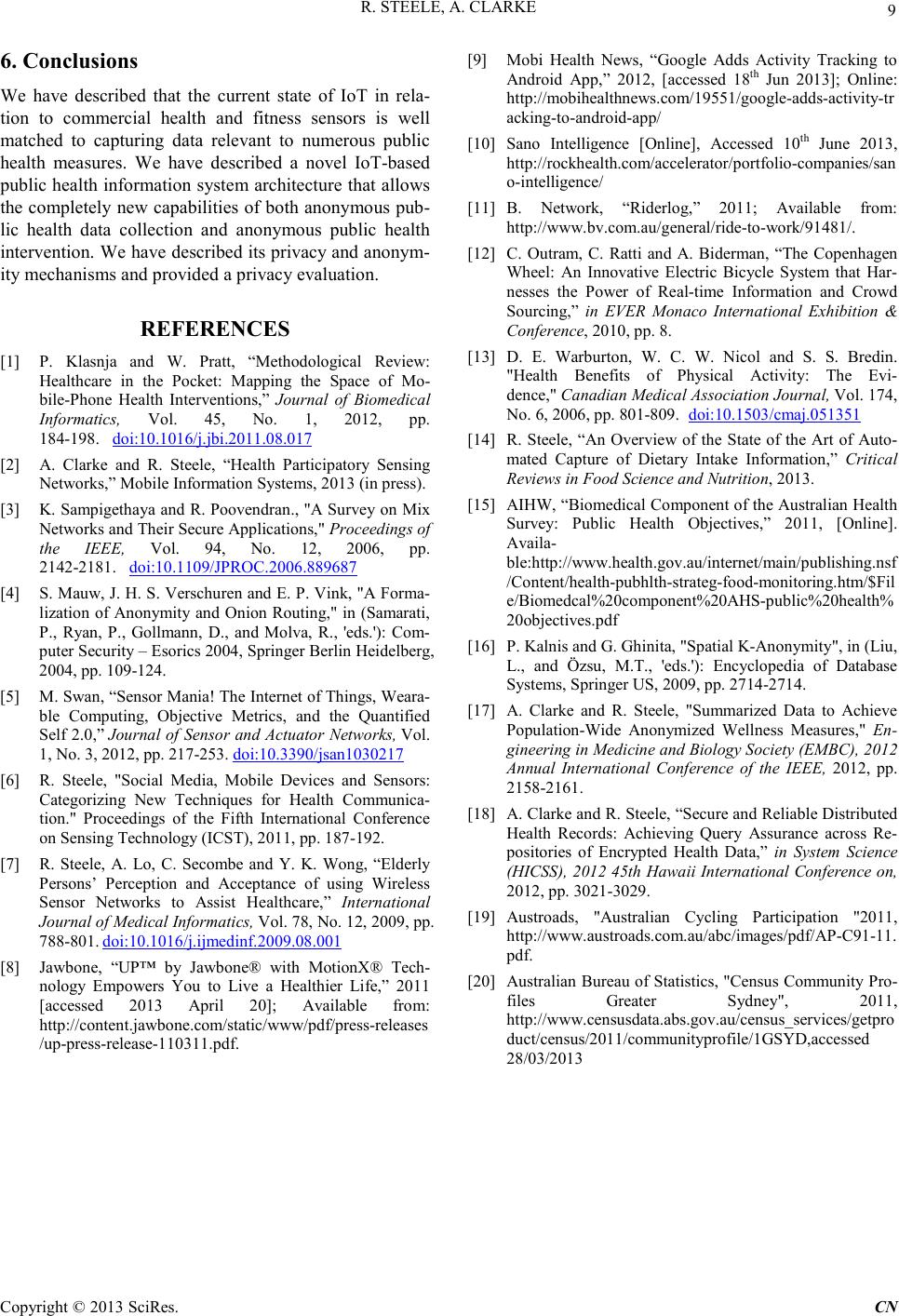
R. STEELE, A. CLARKE
Copyright © 2013 SciRes. CN
6. Conclusions
We have described that the current state of IoT in rela-
tion to commercial health and fitness sensors is well
matched to capturing data relevant to numerous public
health measures. We have described a novel IoT-based
public health information system architecture that allo ws
the completely new capabilities of both anonymous pub-
lic health data collection and anonymous public health
inter ventio n. W e have described its privacy and anonym-
ity mechanisms and provided a privacy evaluation.
REFERENCES
[1] P. Klasnja and W. Pratt, “Methodological Review:
Healthcare in the Pocket: Mapping the Space of Mo-
bile-Phone Health Interventions,” Journal of Biomedical
Informatics, Vol. 45, No. 1, 2012, pp.
184-198. doi:10.1016/j.jbi.2011.08.017
[2] A. Clarke and R. Steele, “Health Participatory Sensing
Networks,” Mobile Information Systems, 2013 (in press).
[3] K. Sampigethaya and R. Poovendran., "A Survey on Mix
Networks and Their Secure Applications," Proceedings of
the IEEE, Vol. 94, No. 12, 2006, pp.
2142-2181. doi:10.1109/JPROC.2006.889687
[4] S. Mauw, J. H. S. Versch uren and E. P. Vink, "A Forma-
lization of Anonymity and Onion Routing," in (Samarati,
P., Ryan, P., Gollmann, D., and Molva, R., 'eds.'): Com-
put er Secu rit y – Esorics 2004, Springer Berlin Heidelberg,
2004, pp . 109-124.
[5] M. Swan, “Sen sor Mania! The Internet of Things, Weara-
ble Computing, Objective Metrics, and the Quantified
Self 2.0,” Journal of Sensor and Actuator Networks, Vol.
1, No. 3, 2012, pp. 217 -253. doi:10.3390/jsan1030217
[6] R. Steele, "Social Media, Mobile Devices and Sensors:
Categorizing New Techniques for Health Communica-
tion." Proceedings of the Fifth International Conference
on Sensing Technology (ICST), 2011, pp. 187-192.
[7] R. Steele, A. Lo, C. Secombe and Y. K. Wong, “Elderly
Persons’ Perception and Acceptance of using Wireless
Sensor Networks to Assist Healthcare,” International
Journal of Medical Informatics, Vol. 78, No. 12, 2009, pp.
788-801. doi:10.1016/j.ijmedinf.2009.08.001
[8] Jawbone, “UP™ by Jawbone® with MotionX® Tech-
nology Empowers You to Live a Healthier Life,” 2011
[accessed 2013 April 20]; Available from:
http://content.jawbone.com/static/www/pdf/press-releases
/up-press-release-110311.pdf.
[9] Mobi Health News, “Google Adds Activity Tracking to
Android App,” 2012, [accessed 18th Jun 2013]; Online:
http://mobihealthnews.com/19551/google-adds-activity-tr
acking-to-android-app/
[10] Sano Intelligence [Online], Accessed 10th June 2013,
http://rockhealth.com/accelerator/portfolio-companies/san
o-int elligence/
[11] B. Network, “Riderlog,” 2011; Available from:
http://www.bv.com.au/general/ride-to-work/91481/.
[12] C. Outram, C. Ratti and A. Biderman, “The Copenhagen
Wheel: An Innovative Electric Bicycle System that Har-
nesses the Power of Real-time Information and Crowd
Sourcing,” in EVER Monaco International Exhibition &
Conference, 2010, pp. 8.
[13] D. E. Warburton, W. C. W. Nicol and S. S. Bredin.
"Health Benefits of Physical Activity: The Evi-
dence," Canadian Medical Association Journal, Vol. 174,
No. 6, 2006, pp. 801-809. doi:10.1503/cmaj.051351
[14] R. Steele, “An Overview of the State of the Art of Auto-
mated Capture of Dietary Intake Information,” Critical
Reviews in Food Science and Nutrition, 2013.
[15] AIHW, “Bi omedical Co mponen t of the Australi an Health
Survey: Public Health Objectives,” 2011, [Online].
Availa-
ble:http://www.health.gov.au/internet/main/publishing.nsf
/Content/health-pubhlth-strateg-food-monitoring.htm/$Fil
e/Biomedcal%20component%20AHS-public%20health%
20objectives.pdf
[16] P. Kalnis and G. Ghinita, "Spatial K-Anonymity", in (Liu,
L., and Özsu, M.T., 'eds.'): Encyclopedia of Database
Systems, Springer US, 2009, pp. 2714-2714.
[17] A. Clarke and R. Steele, "Summarized Data to Achieve
Population-Wide Anonymized Wellness Measures," En-
gineering in Medicine and Biology Society (EMBC), 2012
Annual International Conference of the IEEE, 2012, pp.
2158-2161.
[18] A. Clarke an d R. S teele, “S ecure and Rel iable Distributed
Health Records: Achieving Query Assurance across Re-
positories of Encrypted Health Data,” in System Science
(HICSS), 2012 45th Hawaii International Conference on,
2012, pp . 3021-3029.
[19] Austroads, "Australian Cycling Participation "2011,
http://www.austroads.com.au/abc/images/pdf/AP-C91-11.
pdf.
[20] Australian Bureau of Statistics, "Census Community Pro-
files Greater Sydney", 2011,
http://www.censusdata.abs.gov.au/census_services/getpro
duct/census/2011/communityprofile/1GSYD,accessed
28/03/2013